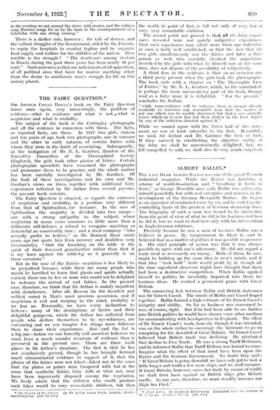THE FAIRY QUESTION.*
SIR ARTHUR CONAN Dosax's book on the Fairy Question raises once again, very interestingly, the problem of evidence—what is evidence and what is not, what is scepticism and what is credulity.
The subject of the book is the Cottingley photographs and all the evidence in connexion with them. The facts, or reported facts, are these. In 1917 two girls, sixteen and ten years of age, took two photographs, one in summer and the other in early autumn, of certain fairies with whom they were in the habit of associating. Subsequently, at the instigation of Mr. E. L. Gardner, Member of the Executive Committee of the Theosophical Society (England), the girls took other photos of fairies. Certain photographic specialists have examined the photographs and pronounce them to be genuine, and the whole matter has been carefully investigated by Mr. Gardner. Of the fruit of these investigations, and his own and Mr. Gardner's views on them, together with additional fairy experiences collected by Sir Arthur from several persons, the present book consists.
The Fairy Question is situated, as regards the extremes of scepticism and credulity, in a position very different from that of Spiritualism, for instance. In the case of Spiritualism the majority is divided into two camps— one with a strong antipathy to the subject, whose scepticism in many eases amounts to little more than a deliberate self-defence, a refusal to recognize anything so distasteful as conceivably true ; and a rival company " who actually prefer to believe," as Mr. Bernard Shaw wrote years ago (we quote him from memory and doubtless very inaccurately), " that the knocking on the table is the spirit of their deceased grandmother rather than that it is my knee against the table-leg as it generally is on these occasions."
But in the case of the Fairies scepticism is less likely to be prejudiced because, while there arc many people who would be horrified to learn that ghosts and spirits actually existed, there can be few or none who would not be delighted to welcome the arrival of real fairies. In the present case, therefore, we think that Sir Arthur is unduly impatient with disbelievers. After all, Reason (in the broadest and noblest sense) is Man's most precious possession, and if scepticism is evil and warping to the mind, credulity is no less so. Personally, we have every inclination to believe : many of the descriptions of fairies and their delightful goings-on, which Sir Arthur has collected from people who declare themselves to be eye-witnesses, are entrancing and we can imagine few things more delicious than to share their experiences. But—and the but is a big one—before we can honestly call ourselves believers we Must have a much sounder structure of evidence than is presented in the present case. There are three weak places in Sir Arthur's structure. The first is that he has not conclusively proved, though he has brought forward much circumstantial evidence in support of it, that the photos of the fairies were not faked—faked not in the sense that the plates or prints were tampered with but in the sense that synthetic fairies, fairy dolls or what not, may have been ingeniously disposed among the vegetation. We freely admit that the children who could produce such fakes would be very remarkable children, but then • The Coming of the Fairies. By Sir Arthur Conan Doyle. London : and Stoualttou. 1128. Cd. net.J
the world, in point of fact, is full not only of very, but of very, very remarkable children.
The second point not proved is that all the fairy experi- ences recorded were not purely subjective experiences. That such experiences may affect more than one individual
at once is fairly well established, so that the fact that the two girls simultaneously saw the fairies and later a third person as well, who carefully checked the apparition- deserilml by the girls with what he himself saw at the swim time, does not dispose of the possibility of subjectivity.
A third flaw in the evidence is that on no occasion was a third party present when the girls took the photographs. The book ends with a chapter on " The Theosophic View of Fairies," by Mr. E. L. Gardner, which, to the uninitiated, is perhaps the most unconvincing part of the book, though read as a fairy story it is delightful. " For the present," concludes Sir Arthur,
" while more evidence will be welcome, there is enough already available to convince any reasonable man that the matter is not one which can be readily dismissed, but that a ease actually exists which up to now has not been skakcn in the least degree by any of the criticism directed against it."
While we cannot agree with the latter half of this state- ment, we can at least subscribe to the first. Meanwhile, we wish Sir Arthur and Mr. Gardner the best of luck.
If they succeed in establishing the objective reality of the fairy we shall be unrestrainedly delighted, but, we fell compelled to add, we shall also be very much surprised.






































 Previous page
Previous page